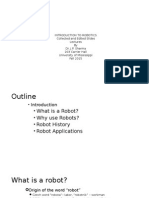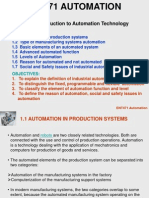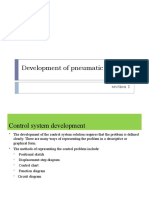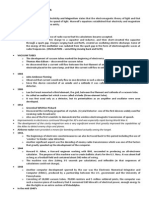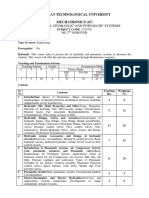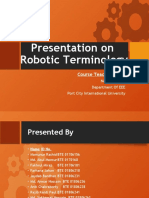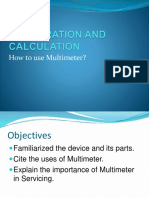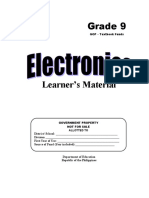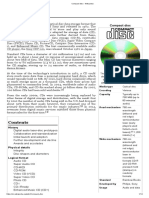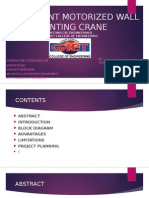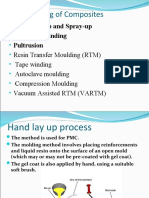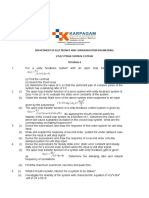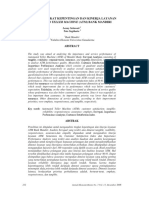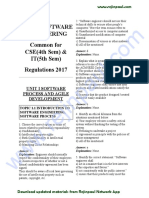AUTOMATION & ROBOTICS
Introduction to Automation
Engr Haider-e-Karar
Teaching Assistant
Mehran University of Engineering and Technology
Engr Haider-e-Karar
�AUTOMATION
A system in which many or all of the processes of production, movement and
inspection of parts and materials are automatically performed or controlled by a
self-operating machinery or electronic device
OR
Automation is the process in industry where various production operations are
converted from a manual process, to an automated or mechanized process
Automation is used to replace humans
Engr Haider-e-Karar
�AUTOMATION
Industrial robotics are said to be the most visible part of automation.
Modern automated processes are mostly controlled by computer programs,
which through the action of sensors and actuators, monitor progress and control
the sequences of events until the process is complete.
Decisions made by the computer ensure that the process is completed accurately
and quickly
Engr Haider-e-Karar
�Example Video on Automation
Engr Haider-e-Karar
�MECHANIZATION VS AUTOMATION
Mechanization refers to the use of powered machinery to help a human operator
in some task
The use of hand-powered tools is not an example of mechanization
The term is most often used in industry. The addition of powered machine tools;
such as the steam powered lathe dramatically reduced the amount of time
needed to carry out various tasks, and improves productivity
Engr Haider-e-Karar
�MECHANIZATION VS AUTOMATION
Mechanization saves the use of human muscles; automation saves the use of
human judgment
Mechanization displaces physical labor, whereas automation displaces mental
labor
Mechanization is the replacement of human power by machine power , whereas
automation is the replacement of human thinking with computers and machines
Engr Haider-e-Karar
�NEED FOR AUTOMATION
Automation would benefit all types of manufacturing industry as well as service
industry, which required their personnel to carry out tasks beyond human
capacity
The typical characteristics of the client that is likely to benefit from automation
are:
High volumes of production,
Process quality difficult to be established by human operations
Hazardous, monotonous or fatigue causing operations
Utilization of production capacity being reduced by operator related delays,
Where manpower related risks are not affordable
Engr Haider-e-Karar
�BENEFITS OF AUTOMATION
High productivity: higher production rates, better capacity utilization
High quality: consistency, predictability, control over process
High flexibility: multi product, multi capacity, without learning curves
Reduced Labor Costs: savings in manpower
Reduced Operator errors: causing quality problems, rework and rejection
costs, and delayed costs & liabilities of product failure
Reduced Operator Hazard & Fatigue: better morale, and reduced costs of
injury and claims
Engr Haider-e-Karar
�LOW COST AUTOMATION
Low cost automation is a technology that creates some degree of automation
around the existing equipment, tools, methods, people, etc.
Using mostly standard components available in the market with low investment,
so that pay back period is short
Major advantages of low cost automation are, low investment, increased labor
productivity, smaller batch size, better utilization of the material and, process
consistency leading to less rejections
Low cost automation may be adopted for: Loading, Welding, Assembly and
Packing etc.
Engr Haider-e-Karar
�TYPES OF AUTOMATION
1. Fixed Automation (Hard Automation)
2. Programmable Automation
3. Flexible Automation (Soft Automation)
Engr Haider-e-Karar
10
�1. FIXED AUTOMATION
Fixed automation refers to the use of special purpose equipment to automate a
fixed sequence of processing or assembly operations.
It is typically associated with high production rates and it is relatively difficult to
make changes in the product design.
This is also called hard automation
Example: 1. GE manufactures approximately 2 billion light bulbs per year
and uses fairly specialized, high-speed automation equipment
2. Paper production
Engr Haider-e-Karar
11
�1. FIXED AUTOMATION
Fixed automation makes sense only when product designs are stable and product
life cycles are long
Advantages
Maximum efficiency
Low unit cost
Automated material handlingfast and efficient movement of parts
Disadvantages
Large initial investment
Inflexibility
Engr Haider-e-Karar
12
�2. PROGRAMMABLE AUTOMATION
In programmable automation, the equipment is designed to accommodate a
specific class of product changes and the processing or assembly operations can
be changed by modifying the control program.
Programmable automation is used when the volume of production is relatively
low and there are variety of products to be made
The example of this kind of automation is the CNC lathe that produces a specific
product in a certain product class according to the input program
Engr Haider-e-Karar
13
�2. PROGRAMMABLE AUTOMATION
Products are made in small batches
In programmable automation, re configuring the system for a new product is time
consuming because it involves reprogramming and set up for the machines and
new fixtures and tools (see example video: YouTube CNC Machine:
https://www.youtube.com/watch?v=srZVB3J6Wb4)
Examples include numerically controlled machines (CNC) etc.
Engr Haider-e-Karar
14
�5 Axis CNC Machine Cutting a Helmet.
Engr Haider-e-Karar
15
�2. PROGRAMMABLE AUTOMATION
Advantages
Flexibility to deal with changes in product
Low unit cost for large batches
Disadvantages
New product requires long set up time
High unit cost relative to fixed automation
Engr Haider-e-Karar
16
�FLEXIBLE AUTOMATION (Soft Automation)
In flexible automation, the equipment is designed to manufacture a variety of
products or parts and very little time is spent on changing from one product to
another
Thus, a flexible manufacturing system can be used to manufacture various
combinations of products according to any specified schedule.
With a flexible automation system it is possible to quickly make changes in the
product (which may be redesigned in reaction to changing market conditions and
to consumer feedback) or to quickly introduce a new product line.
Engr Haider-e-Karar
17
�Example: Flexible Automation
A great example of flexible automation is at the state of the art Tesla
Motors Factory in Freemont, CA. As Chris Anderson says in his
book Makers: The New Industrial Revolution;
Tesla has built the most modern factory in the world. It happens to
build cars, but it could build anything. It is not just automated, its a
veritable robot army. Hundreds of general-purpose KUKA robot arms
do everything from metal-bending to assembly
Engr Haider-e-Karar
18
�Tesla Motors Factory in Freemont, CA.
Engr Haider-e-Karar
19
�FLEXIBLE AUTOMATION
Flexible automation gives the manufacturer the ability to produce multiple
products cheaply in combination than separately
Advantages
Flexibility to deal with design variations
Customized products
Disadvantages
Large initial investment
High unit cost relative to fixed or programmable automation
Engr Haider-e-Karar
20
�AUTOMATION TYPES
Engr Haider-e-Karar
21
�REASONS FOR NOT AUTOMATION
Labor Resistance: People look at robots and manufacturing automation as a
cause of unemployment. In reality, the use of robots increases productivity,
makes the firm more competitive and preserves jobs. But some jobs are lost
Cost of Upgraded Labor: The routine monotonous tasks are the easiest to
automate. The tasks that are difficult to automate are ones that require skill. Thus
manufacturing labor must be upgraded
Initial Investment: Cash flow considerations may make an investment in
automation difficult even if the estimated rate of return is high.
Engr Haider-e-Karar
22
�BUILDING BLOCKS OF AUTOMATION
We can categorize the components of an automation system belonging to one of
the following four classes:
Sensors
Analyzers
Actuators
Drives
Engr Haider-e-Karar
23
�GENERAL BLOCK DIAGRAM
Engr Haider-e-Karar
24
�SENSORS
Sensors are the first link between the typical automated system and the
conventional process
Sensors convey information from the manufacturing process equipment, the
piece of part being manufactured, and from the human operator
Many type of sensors are used in automation e-g:
Manual switches
Limit switches
Proximity switches
Light sensors,
Motion sensors,
Temperature sensors etc.
Engr Haider-e-Karar
25
�ANALYZERS
Once information is sensed it must be registered and analyzed for content and
then a decision must be made by the system to what action to should be taken
This function can be quite complex, and the system components that perform it
are generally too complicated
Most commonly used Analyzers are
Computers
Counters
Timers
Barcode reader
Optical encoder
Engr Haider-e-Karar
26
�ACTUATORS
Once a real world condition is sensed and analyzed something may need to be
done about it
More and more automated systems are closing the loop by taking physical actions
automatically without operator intervention
Cylinders
Solenoids
Relays
Engr Haider-e-Karar
27
�DRIVES
Drives take some action upon the process at the command of the computer or
other analyzer.
The difference between the actuator and the drive is that the actuators are used
for a short, complete discrete motion, usually linear, and drives execute more
continuous movements
Motors
Stepper Motors
DC Servo Motors
Engr Haider-e-Karar
28
�CLASS TEST
Design a control system which contains all building blocks of
automation
Engr Haider-e-Karar
29
�END OF LECTURE
I find that the harder I work, the more luck I seem to have.
Thomas Jefferson
Engr Haider-e-Karar
30






